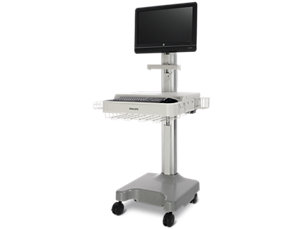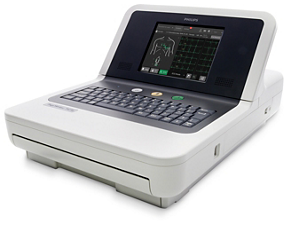- 16-Lead integrated analysis
-
16-Lead integrated analysis supports variety of patients
The Philips DXL ECG Algorithm goes beyond traditional 12-lead interpretation of the resting ECG. It also provides incremental diagnostic capabilities not associated with analysis programs of the past. 16-lead integrated analysis takes advantage of optional right chest and back electrodes to provide extended interpretations for adult chest pain. A 15-lead pediatric analysis is also supported. - ST Maps
-
ST Maps visualize deviations
ST Maps provide a visual representation of ST deviations in frontal and horizontal planes, responding to the 2009 AHA/ACCF/HRS Recommendations.* - Updated criteria
-
Updated criteria based on latest clinical research
The DXL 16-Lead Algorithm includes updated criteria based upon the most recent clinical research. Examples include the addition of “acute global ischemia” and incorporation of updated gender-specific STEMI criteria, as documented in the 2009 AHA/ACCF/HRS Recommendations.* - STEMI-CA criteria
-
STEMI-CA criteria to suggest occlusion site
Provides STEMI-CA (Culprit Artery) criteria to suggest the probable site of the occlusion, consistent with the 2009 AHA/ACCF/HRS Recommendations.* - Critical Value statements
-
Critical Value statements to speed delivery of urgent care
It supports Critical Value statements to highlight conditions requiring immediate clinical attention. Clinicians can quickly take action and reduce the time from the discovery of a critical cardiac event to intervention, such as balloon angioplasty. - LeadCheck program
-
LeadCheck program to prevent mistakes
The LeadCheck program identifies 19 possible lead reversal and placement errors during ECG acquisition. - Updated recommendations
-
Updated recommendations to support high quality standards
The algorithm reflects the updated guidelines and recommendations, such as the 2007 AHA/ACCF/HRS Recommendations Part II**, and the 2009 AHA/ACCF/HRS Recommendations Part VI1 for the Standardization and Interpretation of the ECG. This algorithm is available with a number of Philips products.***
16-Lead integrated analysis supports variety of patients
16-Lead integrated analysis supports variety of patients
ST Maps visualize deviations
ST Maps visualize deviations
Updated criteria based on latest clinical research
Updated criteria based on latest clinical research
STEMI-CA criteria to suggest occlusion site
STEMI-CA criteria to suggest occlusion site
Critical Value statements to speed delivery of urgent care
Critical Value statements to speed delivery of urgent care
LeadCheck program to prevent mistakes
LeadCheck program to prevent mistakes
Updated recommendations to support high quality standards
Updated recommendations to support high quality standards
- 16-Lead integrated analysis
- ST Maps
- Updated criteria
- STEMI-CA criteria
- 16-Lead integrated analysis
-
16-Lead integrated analysis supports variety of patients
The Philips DXL ECG Algorithm goes beyond traditional 12-lead interpretation of the resting ECG. It also provides incremental diagnostic capabilities not associated with analysis programs of the past. 16-lead integrated analysis takes advantage of optional right chest and back electrodes to provide extended interpretations for adult chest pain. A 15-lead pediatric analysis is also supported. - ST Maps
-
ST Maps visualize deviations
ST Maps provide a visual representation of ST deviations in frontal and horizontal planes, responding to the 2009 AHA/ACCF/HRS Recommendations.* - Updated criteria
-
Updated criteria based on latest clinical research
The DXL 16-Lead Algorithm includes updated criteria based upon the most recent clinical research. Examples include the addition of “acute global ischemia” and incorporation of updated gender-specific STEMI criteria, as documented in the 2009 AHA/ACCF/HRS Recommendations.* - STEMI-CA criteria
-
STEMI-CA criteria to suggest occlusion site
Provides STEMI-CA (Culprit Artery) criteria to suggest the probable site of the occlusion, consistent with the 2009 AHA/ACCF/HRS Recommendations.* - Critical Value statements
-
Critical Value statements to speed delivery of urgent care
It supports Critical Value statements to highlight conditions requiring immediate clinical attention. Clinicians can quickly take action and reduce the time from the discovery of a critical cardiac event to intervention, such as balloon angioplasty. - LeadCheck program
-
LeadCheck program to prevent mistakes
The LeadCheck program identifies 19 possible lead reversal and placement errors during ECG acquisition. - Updated recommendations
-
Updated recommendations to support high quality standards
The algorithm reflects the updated guidelines and recommendations, such as the 2007 AHA/ACCF/HRS Recommendations Part II**, and the 2009 AHA/ACCF/HRS Recommendations Part VI1 for the Standardization and Interpretation of the ECG. This algorithm is available with a number of Philips products.***
16-Lead integrated analysis supports variety of patients
16-Lead integrated analysis supports variety of patients
ST Maps visualize deviations
ST Maps visualize deviations
Updated criteria based on latest clinical research
Updated criteria based on latest clinical research
STEMI-CA criteria to suggest occlusion site
STEMI-CA criteria to suggest occlusion site
Critical Value statements to speed delivery of urgent care
Critical Value statements to speed delivery of urgent care
LeadCheck program to prevent mistakes
LeadCheck program to prevent mistakes
Updated recommendations to support high quality standards
Updated recommendations to support high quality standards
Documentation
-
Product overview (1)
-
Product overview
- Philips DXL Algorithm Overview (7.0 MB)
-
Product overview (1)
-
Product overview
- Philips DXL Algorithm Overview (7.0 MB)
-
Product overview (1)
-
Product overview
- Philips DXL Algorithm Overview (7.0 MB)
Related products
Alternative products
-
IntelliSpace ECG
- Custom set-up meets your individual needs
- Central access point simplifies ECG workflow
- Flexible design to reduce costs
- Scalable system to grow with you
View product
-
ST80i
- Wireless design enhances patient mobility
- Intuitive user interface (GUI) simplifies workflow
- Flexible interoperability supports multiple connectivity options
- Sophisticated algorithms support confident diagnoses
View product
-
PageWriter TC35
- Advanced tools to enhance workflow and support clinical decisions
- Clinical excellence of the DXL ECG Algorithm which is built upon over 55 years of research
- Native DICOM modality worklists can be downloaded or ADT information retrieved
- WLAN export via 802.11 a/b/g/n/ac WiFi 5 and WPA3 Personal security to an electronic medical record
- Standard Options: Network Print; XML/PDF; Crit Values; 300 Hz Filter; LAN; Custom Fields; Encryption
View product
-
Device Management Dashboard
- Centralized device management
- Efficient fleet maintenance
- Web-based access serves your facility’s needs
View product
-
IntelliSpace ECG
Philips IntelliSpace ECG provides fast, easy access to ECGs from almost anywhere, anytime to enhance your workflow through extensive connectivity.
View product
-
ST80i
Philips ST80i Stress Testing System opens up new paths for productivity & decision-making. Its wireless design, bi-directional connectivity, and advanced decision-making support tools enhance data review, patient care, and efficiency.
View product
-
PageWriter TC35
The PageWriter TC35 cardiograph provides advanced tools to enhance workflow and support clinical decisions. All PageWriter cardiographs include the clinical excellence of the DXL ECG Algorithm which is built upon over 55 years of research and experience. The cardiographs provide continuity and consistency in ECG reading and diagnosis through PageWriter cardiographs, the IntelliSpace ECG management system, and other Philips solutions throughout the healthcare enterprise. Native DICOM modality worklists can be downloaded, or ADT information retrieved, providing patient demographics at the bedside. ECG reports can be wirelessly exported using 802.11 b/a/g/n/ac WiFi 5 speed and WPA3 (Personal) security to an electronic medical record. PageWriter’s native DICOM interoperability provides direct access to ECG orders from your current DICOM MWL provider and storage of resulting DICOM format ECGs to your existing PACS. The result – a fast, efficient clinical workflow with reliable operation for you and your patients.
View product
See all related products
- 1 AHA/ACCF/HRS Recommendations for the Standardization and Interpretation of the Electrocardiogram, Part VI: Acute Ischemia/Infarction. Circulation 2009; 100:e262-e270.
- 2 AHA/ACCF/HRS Recommendations for the Standardization and Interpretaton of the Electrocardiogram, Part II: Electrocardiography Diagnostic Statement List. J Am Coll Cardiology, 2007:49:1128-135.
- 3 The DXL ECG Algorithm is available on the PageWriter TC70 and TC50 Cardiograph with the features and capabilities described above. The DXL Algorithm is also available on PageWriter TC30, TC20, and TC10; IntelliVue patient monitors; IntelliSpace ECG; and ST80i stress system with differentiated sets of features.




